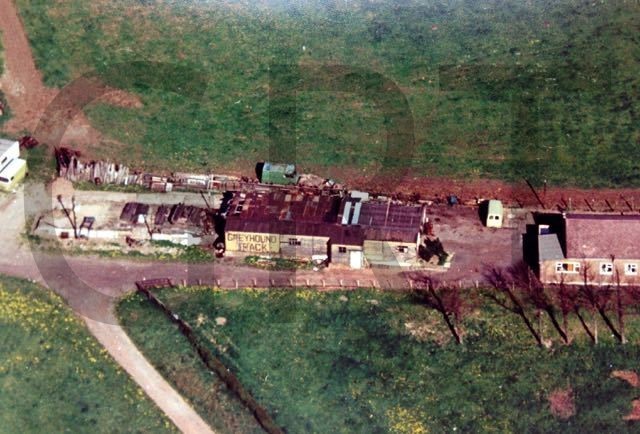Coundon Greyhound track, Broomside, Coundon, County Durham.
POSTCODE———————————-DL14 8PY
LOCATED————————————The site is located two miles east of Bishop Auckland, west of Coundon villagemon far grazing land known as Broomside, adjacent to the Coundon Bungelow between the B6287 and A689 roads.
ORIGINAL SITE—————————–Land that was once occupied by Bishops Park Colliery.
DATE CONSTRUCTED——————–1936
DATE VENUE OPENED——————-1938
Meaning other sports may have taken place prior to the arrival of Greyhound Racing.
FIRST MEETING—————————–October 1st 1938.
Greyhound Racing only.
LICENSED OR INDEPENDENT———-Independent
All venues covered would have to be licensed with the government, licensed suggested in this section would refer to tracks operating under NGRC Rules.
INSIDE OR OUTSIDE HARE TYPE——Don’t know
Please note that the Electric Hare suggested is only a guidance and would have been in operation for a certain amount of time at this venue. Although it is not necessarily guaranteed that it was operational all the time, as other types of lure may have been used and updated as time progressed.
DISTANCES———————————–Don’t know
Please note that most racing venues distances had become varied throughout the years, the ones given above were at once point set and offers only a guidance to the track size.
CIRCUMFERENCE—————————Don’t know
Please note that alterations at most racing venues throughout its existence would see that the circumference of the track would vary, the one shown above offers only a guidance to the track size.
BIG RACE NAMES—————————Nothing known of.
STADIUM SHARED WITH——————Whippet Racing.
LAST MEETING——————————-1970
Greyhound Racing only.
STADIUM CLOSURE DATE—————-1970
Meaning other sports may have taken place after Greyhound Racing had ceased.
STADIUM DEMOLITION——————-Dwindled to farm use over the years.
BUILT ON SITE——————————-The site of the track has now returned to grazing land.
In some cases, structure’s that originally covered the venue after the stadium had been demolished, may have been themselves demolished too, so the one described is more likely to be the one which now presently covers the site.
EVIDENCE LEFT TODAY——————-Some of the outbuildings for the track are stull there with the old totebooth building still has its own booth windows..
FURTHER COMMENTS——————–None











The small rural village of Coundon lies two miles east of Bishop Auckland, situated in the heart of County Durham’s once busy coal mining vicinity. The village, had been the home to some of the earliest coal mines in Durham, some dating as far back as the 14th century, and yes when reading this section, that you could say thanks to the coal mining industry for playing its part on how this greyhound track developed on the outskirts of Coundon.
During the 1920’s the industry itself had become associated with the sport of Whippet Racing, and it was on the land left abandoned after the closure of the Bishops Park Colliery, that Whippet Racing began to flourish during the 1930’s. The pit was also known to locals as the Jawblade Pit, due the large whale jawbone found at the entrance to the pit, which doubled as an archway to were so many miners would have passed through on their way to work.
The field on which the whippets raced lay south of the village in a field which by 1936 had developed into a small enclosed grass circuit, situated along the side of a farm, which had now become its headquarters. The 1930’s had also seen the arrival of Greyhounds Racing at other tracks in the north east, and soon became clear that it would overshadow the Whippet Racing of the miners, which influenced the land owner to switch his ideas to lay a more permanent greyhound track.
During April 1938 a successful application was made for a license to hold regular meetings, and on the 1st of October 1938, Coundon staged its inaugural meeting. Like most greyhound tracks, the declaration of the Second World War had seen a temporary closure, yet Coundon continued to run meetings throughout the hostilities, albeit with events run during daylight hours only.
In 1960 an incident made newspaper headlines after a meeting was raided by police, a tip off had exposed an on duty policemen consuming alcohol and gambling during meetings. The bad publicity contributed to the closure of the track, and it seemed as though Greyhound Racing was at an end at Coundon. Fortunately, a family run business purchased the site and took on the lease and continued to promote the sport. But it was during the late 1960’s that Greyhound Racing at Coundon was weakening mainly due to the lack of support of both greyhounds and punters, and eventually closed in 1970.
After the tracks facilities had been removed the land returned back to a more recognised farm meadow. But luckily enough, some of the farm buildings that once played a part in the running of the track, that once acted as storage and kennels still exist, even up until recently a photograph shows the tote betting booths still in good order hidden behind clutters of rubbish. These buildings are now found lying west of the field, and are part of the premises known as not surprisingly The Coundon Stadium Bungalow, which is situated close to the road junction of the B6287 and the A689.
A programme, photograph or even memorabilia for this track is required for this page, if you can help please contact me.

Recent Comments